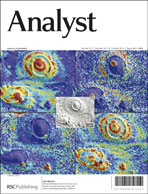Silica-based monolithic materials have shown great promise for use as sorbent materials due to their large surface area and bimodal pore size distribution. In this paper, a new process for the fabrication of a silica-based monolith inside a glass microchip and its modification with octadecylsilyl ligands was successfully developed for use in the microchip-based solid phase extraction of proteins. Monolithic porous silica without cracks was prepared by a sol–gel process, followed by placement of the monolithic silica disk inside the extraction chamber in the base plate of the microchip. The two plates of the glass microchip were then thermally bonded at 575 °C for 3 hours. The silica-based monolith was not affected by the thermal bonding of the two plates of the microchip. This process completely avoids the problem of shrinkage in the silica skeleton during preparation. The monolithic silica disk inside the glass microchip was subsequently modified with octadecylsilyl (C18) moieties for increased protein binding capacity. The performance of the microchip was evaluated using the extraction of six proteins varying in molecular weight and isoelectric point, namely insulin, cytochrome C, lysozyme, myoglobin, β-lactoglobulin, and hemoglobin at a concentration of 60 μM. The standard protein was mixed with a double concentration of the detergent 3-[(3-cholamidopropyl)dimethylammonio]-1-propanesulfonate (CHAPS). The results show that the octadecylated silica monolith was permeable, has the ability to remove impurities, and achieved a high extraction recovery of the proteins (94.8–99.7%) compared with conventional octadecylated silica particles (48.3–91.3%). The chip-to-chip reproducibility was assessed by calculating the relative standard deviations (RSDs) for the six proteins during extraction. The intra-batch and inter-batch RSDs were in the range of 2.0–4.5% and 2.9–6.4%, respectively. This new microfluidic device for protein extraction may find an application in the area of proteomic research.

You have access to this article
 Please wait while we load your content...
Something went wrong. Try again?
Please wait while we load your content...
Something went wrong. Try again?


 Please wait while we load your content...
Please wait while we load your content...